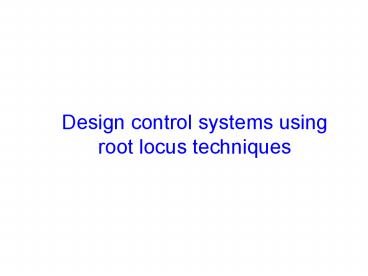Design control systems using root locus techniques - PowerPoint PPT Presentation
1 / 56
Title:
Design control systems using root locus techniques
Description:
before lag compensation; b. after lag compensation. The ratio between the static gains: ... of the system for Example 9.2 using different lag compensators ... – PowerPoint PPT presentation
Number of Views:1118
Avg rating:3.0/5.0
Title: Design control systems using root locus techniques
1
Design control systems using root locus techniques
2
(No Transcript)
3
(No Transcript)
4
If you equate the characteristic polynomial to
zero, you can get the system poles
5
A value of s will be a closed loop pole if
6
The next question is for what K this will happen
7
(No Transcript)
8
(No Transcript)
9
(No Transcript)
10
- Some useful concepts
- Number of branches The number of branches of the
root locus equals the number of closed-loop poles - Symmetry The root locus is symmetrical about the
real axis. This comes from the fact that there
can not exist characteristic polynomials with
complex coefficients. Therefore, the complex
poles should exist in conjugate pairs.
11
Some useful concepts 3. Real-axis segments On
the real axis, for K gt 0, the root locus exists
to the left of an odd number of real axis, finite
open-loop poles and/or finite open-loop zeros.
12
4. Starting and ending points
For small gains,
For small gains, the closed loop poles approach
the combined poles of G(s) and H(s)
13
4. Starting and ending points The root locus
starts at the poles of G(s)H(s), the open loop
transfer function.
At high gains,
At high gains, the root locus approaches the
roots of G(s)H(s)
14
4. Starting and ending points The root locus
starts at the poles of G(s)H(s), the open loop
transfer function. The root locus starts at the
poles of G(s)H(s) and ends at the zeros of
G(s)H(s)
15
(No Transcript)
16
5. Behavior at infinity
Therefore, when s goes to infinity, KG(s)H(s)
goes to zero. That means, it has three zeros at
infinity.
17
5. Behavior at infinity The root locus
approaches straight lines as asymptotes as the
locus approaches infinity. Further, the equation
of the asymptotes is given by the real-axis
intercept, , and angle as follows
18
Break away and break in points
Where z and p are the negative of the zeros and
poles of G(s)H(s)
19
(No Transcript)
20
(No Transcript)
21
Step responsesof second-orderunderdamped
systemsas poles movea. with constant real
partb. with constant imaginary partc. with
constant damping ratio
22
(No Transcript)
23
Second-orderunderdampedresponsespecifications
24
(No Transcript)
25
Percentovershoot vs.damping ratio
26
Normalized risetime vs. dampingratio for
asecond-orderunderdampedresponse
27
Pole plot for anunderdamped second-ordersystem
28
Lines of constantpeak time,Tp , settlingtime,Ts
, and percentovershoot, OSNote Ts2 lt Ts1
Tp2 lt Tp1 OS1 ltOS2
29
Initial value theorem
if the limit exists
Final value theorem
if sY(s) does not have poles on or to the right
of the imaginary axis in the s-plane.
30
(No Transcript)
31
Root locus foruncompensatedsystem ofFigure
9.4(a)
32
(No Transcript)
33
Root locusa. before lag compensationb. after
lag compensation
34
The ratio between the static gains
35
Compensate the system in (a) to improve the
steady state error by a factor of 10, if the
system is operating with a damping ratio of 0.174.
36
(No Transcript)
37
(No Transcript)
38
Compensated systemfor Example 9.2
39
Root locus forcompensated system of Figure 9.11
40
Predicted characteristics of uncompensated and
lag-compensated systems for Example 9.2
41
Step responses ofuncompensated
andlag-compensatedsystems forExample 9.2
42
Step responses of the system for Example 9.2
using different lag compensators
43
If the transient response has to be improved, one
option is to change the gain till the closed loop
poles move to the desired point. If the root
locus does not go through the required point, the
root locus has to be re-shaped by adding poles or
zeros so that the new (compensated) root locus
goes through the desired point
Ideal derivative or PD controller
44
a. uncompensatedb. compensatorzero at
2(figure continues)
45
(continued)c. compensatorzero at 3d.
compensatorzero at 4
46
Since the damping ratio is the same, the
percentage overshoot will be the same.
47
Uncompensated system and ideal derivativecompensa
tion solutions from Table 9.2
48
Design an ideal derivative compensator to yield a
16 overshoot with a threefold reduction in the
settling time.
49
Root locus for uncompensatedsystem
50
The second order assumption is valid since the
real part of the dominant poles is less than 1/5
of the rest of the poles
51
Compensateddominant polesuperimposed over the
uncompensatedroot locus
52
Sum of the angles -275.6 Therefore, the angular
contribution required 275.6 180 95.6
53
Figure 9.20Evaluating the location of the
compensatingzero for Example 9.3
54
Figure 9.21Root locus for thecompensated system
of Example 9.3
55
Figure 9.22Uncompensated andcompensated system
step responses ofExample 9.3
56
PD controller






























